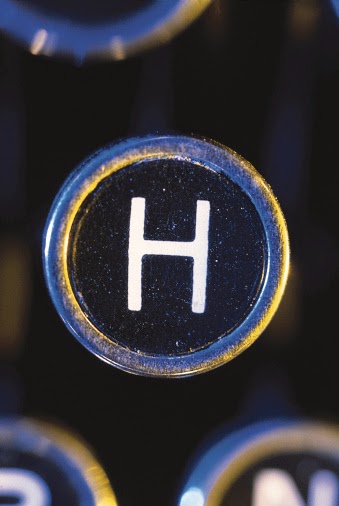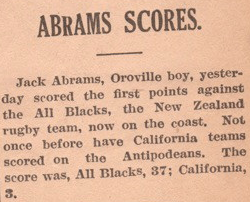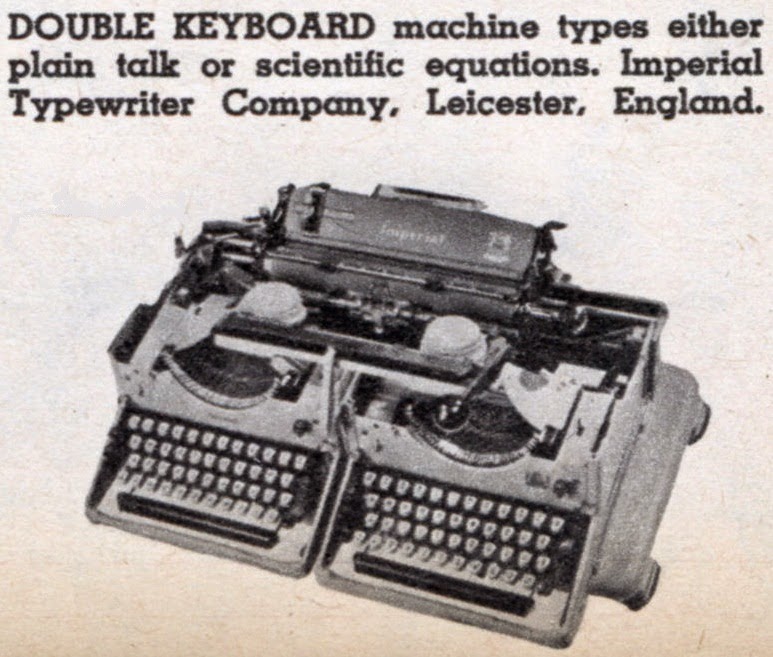Know exactly how it feels ...
From the Auckland Star, New Zealand, 1903:
You're better off sending it to, if you can find such a thing:
Typewriters Galore
On the subject of typewriter-spotting, the new BBC America miniseries Fleming: The Man Who Would Be Bond, about the early career of James Bond creator Ian Fleming, is offering hundreds of opportunities. I caught the first two episodes last night. I didn't correctly spot all the typewriters on offer (most seem to be Imperial standards, naturally enough), but I did see that at least one oddball flatline portable had managed to make its way into the filming.
The most amusing choice by the producers, however, is the East German Optima Elite 2 portable seen being used by actor Dominic Cooper (playing Fleming) in Fleming's later life, in Jamaica, around the time of the making of Dr No. Fleming, of course, used a Triumph at that time. Well, I suppose the shape is approximately the same!:
As might be expected, Cooper-Fleming is most often seen with a Royal portable, though not a gold-plated one (at least not so far in the series):
I'm guessing Royal Navy Second Officer Monday became Miss Moneypenny:
Typewriters aside, this is shaping as a most entertaining series. The idea that "No Sex, Please, We're British" appears to have been cast deeply asunder.
Imperial Doppelgänger
Mention of Imperial standards brings me to this £300 offering in Nottinghamshire, England (home of the British Bar-Lock, Bar-Let and Byron). I was alerted to the Gumtree listing by my Normandy friend, the former Fleet Street journalist Christopher Long (who somehow, oddly enough, puts me in mind of Ian Fleming! Perhaps there's a Bond novel in him?). The listing points to my post on the designer, Claude Wellington Robert Brumhill. I wonder if it ever extended to three machines? Typewriter Shines Again
One movie typewriter which has become increasingly familiar over the years is the one used by Jack Nicholson in Stanley Kubrick's The Shining. A Kubrick exhibition opened at the TIFF Bell Lightbox in Toronto on the weekend, displaying props, costumes and photographs of the director's most memorable movies. The Adler standard seen above is among the items featured.
In praise of the typewriter
Richard Polt very kindly forwarded me this scan of the lovely Thomas Walton column which appeared in the Toledo Blade last month. I don't recall the newspaper newsroom switch to "modern technology" quite as vividly as Thomas does, but I do recall that I resisted it as long as I could. Easter Island typewriters
Another TV program I caught last week was an absolutely fascinating story of Easter Island, "Mysteries of a Lost World". Having often expounded at typewriter presentations on the virtues of the Blickensderfer 5 - most especially when it comes to a situation in which one is stuck in a place as extremely isolated as this - I began thinking about typewriters on Easter and researching the subject. Amusingly, one of the first images I came across was this one, illustrating that typebars can look like moai, the stone statues created by the Rapa Nui people: "Mysteries of a Lost World" didn't expound on the virtues of the Blick, but it did heap praise on an Englishwoman, Katherine Routledge (1866–1935), an amateur anthropologist who visited Easter in 1914. And I did discover that while writing the results of her groundbreaking survey there, Routledge ran out of typewriter ribbon ink - something that might never have happened had she been using a Blick. The TV program also praised research work carried out at Easter by Thor Heyerdahl's team in 1955-56. This team included the American anthropologist William Mulloy (1917–1978), seen above using a Smith-Corona portable on Easter. Furrked
A few images have been appearing of cats at typewriters (including this lovely one from Ted Munk):
A friend of a friend has come up with a new word she is offering to the Oxford English Dictionary. It is "furrked": Furrked: (ferkt, adj.) - The state of being covered in cat fur, invoking a sense of frustration; as “This couch is furrked, I have fur all over my trousers now, dammit”. Also v: "Puss has furrked me!"
During all the excitement here this weekend, my "furrking cat", Charlie the Typewriter Guard Cat, gently slept. Which is probably just as well, since as the weather warms up, cats do tend to shed their winter coats:
What a Weekend!
I am steadily recovering from a fun-filled, action-packed weekend, highlighted by my son Danny's wonderful wedding on Saturday (more on that later). The fun continues this morning, when I expect another 50 typewriters to leave the house. Yesterday we celebrated the 60th birthday of John Stephens, a Canberran who has a fascination with things Art Deco and has accrued a small but impressive collection of Art Deco typewriters. The shindig was held at the Beyond Q Bookshop & Cafe in Curtin, which has a few uncared-for and dusty old typewriters stashed among its many shelves. Below, mutual close friend Peter Crossing bangs out a best wishes message to John on a suitably adorned Swissa Piccola portable:
![]()
![]()
![]()
![]()
![]()
Just briefly on THE wedding (which I shall return to shortly, in another post), it looked like we were in for some stormy weather, but while the wind picked up, the rain thankfully stayed away. Just in case of an emergency, Danny's gorgeous bride Emily Hansen tested out a Royal typewriter shower hat:
But it wasn't needed, because while dark clouds gathered, they didn't dampened this marvellous occasion:
While all this excitement was going on, over in Chicago the mighty New Zealand All Blacks rugby union team beat the United States 74-6 in the Test match played before a packed house (62,000) at Soldier Field (which means the record of only two touchdowns ever having been scored by Americans against the All Blacks, in 1913 and 1954, still stands):The haka before the match:And while this match was being played, in Kobe the Maori All Blacks beat Japan 61-21 - big day for NZ rugby! (In rugby league, the NZ Kiwis beat Samoa.)In Hobart, meanwhile, talkative Fred the sulphur-crested cockatoo, received a congratulatory typewritten letter from the Queen for reaching 100 years of age. I kid you not!: Typewriter-fuelled ambitions
During the fiercely contested 11th general elections in Botswana last month, Duma Boko, as leader of the Umbrella for Democratic Change Party, made considerable inroads in establishing a legitimate opposition to Ian Khama's ongoing control. Boko"emerged from a low-income neighbourhood of Mahalapye to become a poised presidential candidate". Boko's friends recalled him "growing up in a rural village, where toys, television sets and a family vehicle were a luxury that could engender envy among neighbours, owning such could catapult one to celebrity status. It was even a huge achievement if such a toy was a typewriter."
"In addition to being a sublime debater and brilliant student, Boko had a special possession that made him big among his peers – a typewriter, which made him the envy of his age-mates. [A friend said] 'It was our first time to see a typewriter and our ambition was just to touch it. A typewriter. [Boko] already had the proficiency to use it. I remember one of my friends who wanted to write a letter to his girlfriend came to beg Duma to type the letter. A typewriter, can you imagine? Man, he put a lot of terminology in that letter and the girl felt honoured ...'"
Miss Typewriter
Bum's Up!









































.jpg)






.png)















.jpg)


































.jpg)
































.jpg)











.jpg)




































































































